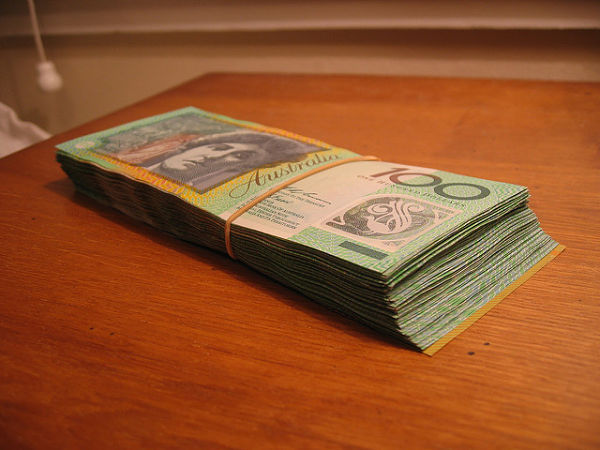
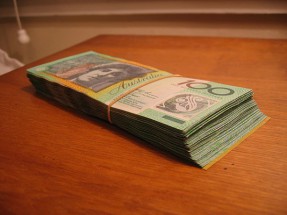
Forget Bitcoin, Block Chain and all those other new-fangled internet platforms like Apple Pay – when it comes to holding a fat stash of cash, Australians still demand the green folding stuff: those crisp $100 bills.
But our national love affair with holding some hard currency on the side has produced a nasty side effect for people and businesses that prefer cash over cards: despite Australia having the best banknotes in the world, forged notes are now the increase.
“Counterfeiting rates of the current series of banknotes remain low by international standards but have been rising,” the Reserve Bank of Australia’s Head of Payments Policy, Tony Richards, told the Payments Innovation 2016 Conference in Sydney on Tuesday.
“And there are some signs that the counterfeiters are getting a bit better with new and cheaper scanning, printing and image manipulation technology.”
That’s good news for Officeworks; not exactly good news for the RBA, police, Treasury or the Australian Taxation Office. And don’t mention the camera on the iPhone 6.
(If you’re unsure about how to spot a fake note, watch the helpful RBA tutorial below)
But there’s also a much deeper story inside what’s happening with cash.
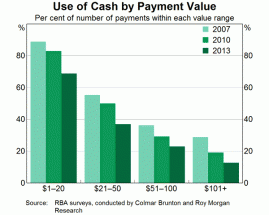
For years authorities have been watching incidents of dodgy bank notes decline: thanks largely to technological marvels like tap-and-go payments to nifty secure micro printing features used in Australia’s polymer banknotes.
What the cash holding and forgery uptick really gives us is a very clear sign of the technological and economic times: in a digital age, cash has very rapidly become the last truly anonymous payment instrument.
If you don’t want to use a bank for, um, whatever reason, cash is about your only way of existing as either a business or an individual.
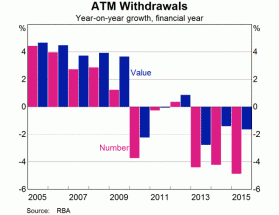
Tax collectors, police and anti-money laundering authorities all naturally view cash businesses with legitimate suspicion; after all it’s a lot harder to catch dodgers and felons when they don’t leave a convenient trail using bank accounts or credit cards.
Payments paradox
But there’s also more nuanced argument of what role of old fashioned banknotes really play in the wider economy, and it represents something of a paradox.
The RBA’s Tony Richards puts it pretty neatly here:
“While the use of cash in transactions has been declining, the demand to hold cash has continued to grow. This is the case for low denomination banknotes as well as high denomination ones.
“Indeed, in recent years there has been a modest increase in the rate of growth of banknotes on issue, to an annual rate of around 7 per cent over the past couple of years. More broadly, over the longer term, growth in banknote holdings has been largely in line with nominal growth in the overall economy.”
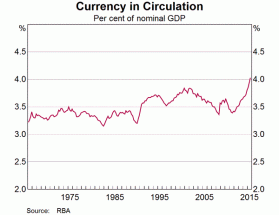
There’s bit to unpack in those four sentences, but the biggest takeaway is that cash holding remains strong and demand is increasing.
The reasons are many and varied; one of them is certainly that some people and businesses prefer to keep payments ‘off the grid’ lest they be detected by the likes of the ATO, Child Support or Centrelink.
But as a few bank economists have privately observed, having a bit of a cash buffer – even if it’s dark, untaxed and unbanked – could just provide some fortuitous insulation from otherwise nasty economic circumstances.
If a café owner, carpenter or mechanic does a cash job for a discount during lean times, and they then pass that on to casual staff, it could potentially make the difference between both of them staying afloat and off welfare.
It’s not ideal, but arguably less economically harmful than falling back on taxpayer funded welfare benefits.
Similarly, tradies or other self-employed people who fall back on their ‘cash stash’ to cover expenses and then put declared income towards mortgages or other secured or unsecured credit products a probably at less risk of default on their loans, something banks might appreciate more than the ATO.
(Inside banks, one of the clearest red flags for signally financial distress is when customers resort to making cash withdrawals on credit cards, transactions that normally start accruing high interest immediately without the usual interest free period because of their high default risk.)
Cash balancing act
So there’s clearly a bit of a delicate balancing act when it comes to judging just how much cash to put into circulation, especially when not all of it is as transactionally active as it otherwise might be.
Again, Tony Richards puts it pretty neatly:
“Despite the decline in use in transactions, cash is likely to remain an important part of both the payments system and the economy more broadly for the foreseeable future.
“In particular, significant parts of the population appear to remain more comfortable with cash than with other payment methods in terms of ease of use for transactions or transfers, as a backup when electronic payment methods may not be available, or as an aide for household budgeting.”
Old money is new money
Of course the RBA is in the business of printing money, some of which Australia exports overseas to nations where forged currency has historically been a much bigger problem.
Richards says that the RBA is now “undertaking a major project to upgrade the existing stock of notes.”
“The program for the next generation of banknotes includes major security upgrades that should ensure that Australia’s banknotes remain some of the world’s most secure,” he says, adding that the first release of the new will be in September with the new five dollar note.
And the notion of a ‘cash-less’ society? Richards observes it might could also be about ‘less-cash’.
Time and effective tax rates will tell.
Comment below to have your say on this story.
If you have a news story or tip-off, get in touch at editorial@governmentnews.com.au.
Sign up to the Government News newsletter
